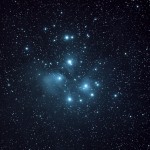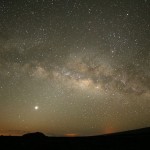The plan was to do some astrophotography Saturday night. The weather forecast forced a re-schedule, a winter storm arriving Saturday afternoon, Friday it was to be.

Setting up at the Mauna Kea VIS means a crowd of people. Hundreds of tourists that have come to enjoy a dark Mauna Kea Sky. I was joined by Raymond, a Hilo amateur also looking to take some photos. We setup side by side in a parking space just off the patio where the VIS was setting up their telescopes for the night. We would be in the center of the crowd for a while.
The VIS offers power, outdoor receptacles are available, allowing me to bring my large and power hungry laptop to run the setup. Not entirely trusting that the extension cord would remain plugged in during all of the activity, I used a battery pack for the telescope and camera. The laptop batteries are pretty old, but they will last the few minutes needed to replug the cord.
For my first target I choose M45, the Pleiades. The bright star cluster would give me a pretty target to check out the setup, provide something showy on the screen, and allow time for the crowd and the lights to vanish into the night. Once the gear was running smoothly I had plenty of time to explain astrophotography to a very interested gathering. For a couple hours I hosted a semicircle of folks in the glow of the computer screen, explaining long exposure astrophotography, tracking and guiding, calibrating and stacking images, all of the work that goes into a completed astrophoto.
Raymond was playing with a new camera, a Canon 5DMkIII. A longtime regular, often joining the crew at the MKVIS, he is new to astrophotography and wanted a few pointers. I demonstrated focusing with a Bahtinov mask and suggested targets for him. With an old Losmandy G11 mount, a very nice 80mm refractor and the 5DMkIII he had good gear. A touch of help and he was soon producing very nice results. I look forward to see his results on a bigger screen.
With the crowd fading and taking the lights with them I turned to the primary target of the night, the Rosette nebula. I hoped to add another few couple hours of data to the hours taken from the driveway. I captured another 30 four minute exposures with no trouble, the gear working perfectly, the guiding locked on.
My stop at the Rosette completed I worked my way along the southern Milky Way. οVelorum, ηCarina, and IC2948 were all targeted. In the middle of the last one the battery died that was using for the camera and telescope. This required a realignment to fix. Meanwhile the extension card had not been touched.
Raymond pulled out about 2am. My gear was running well, no reason to stop while I still had the dark. I pulled out some homemade dried bananas and mangoes to fuel the run for dawn.

Driving down I discovered that the fog was only on the side of the mountain. The saddle between Mauna Kea and Mauna Loa beautifully clear. I stopped and reconfigured the camera and tripod for starscape photography. For the next hour, until the first light of dawn crept in from the east, I shot still photography along Saddle Road near the Mauna Kea junction.
I arrived home tired and ready for a bed. A precious SD card full of treasure was dumped to the hard drive for safekeeping. Later I would find out if any of the images are good. Whether any decent photos result or not, it was still worth a trip into the dark.
As for Saturday night? Looks like a complete fogout in the webcams this evening.

